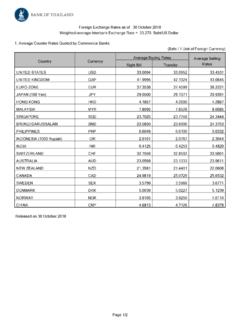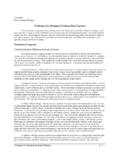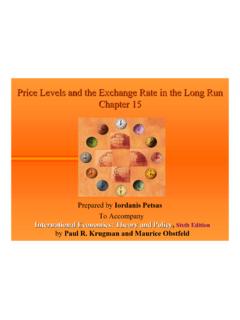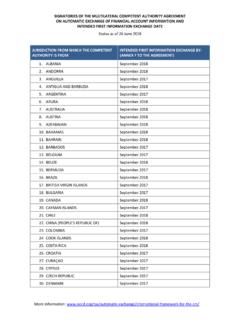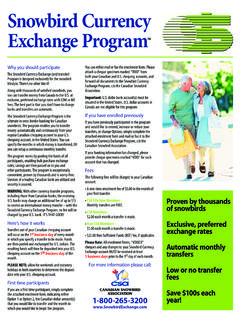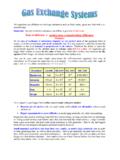Transcription of Nontradable Goods and the Real Exchange Rate
1 Open Econ RevDOI ARTICLEN ontradable Goods and the real Exchange RatePau Rabanal Vicente Tuesta Springer Science+Business Media New York 2012 AbstractHow important are Nontradable Goods and distribution costs toexplain real Exchange rate dynamics? We answer this question by estimatinga general equilibrium model with intermediate and final tradable and non-tradable Goods . We find that the estimated model can match characteristicsof the data that are relevant in international macroeconomics, such as realexchange rate persistence and volatility, and the correlation between thereal Exchange rate and other variables.
2 The distinction between tradable andnontradable Goods is key to understand real Exchange rate fluctuations, butthe introduction of distribution costs is not. Nontradable sector technologyshocks explain about one third of real Exchange rate volatility. We also showthat, in order to explain the low correlation between the ratio of relativeconsumption and the real Exchange rates across countries, demand shocks wish to thank Pablo Guerr n and Carlos Montoro for helpful discussions, and ananonymous referee for very helpful comments.
3 The opinions expressed in this paper arethose of the authors and should not ne attributed to the IMF or IMF policy. Any errorsand omissions are our own. Additional material is available in an online appendix RabanalInternational Monetary Fund, 700 19th St.,Washington DC, NW 20431, USAe-mail: Tuesta (B)CENTRUM Cat lica, Pontificia Universidad Cat lica del Per ,Lima, Perue-mail: Rabanal, V. TuestaKeywordsReal Exchange rates Nontradable Goods Nominal rigidities Bayesian estimationJEL ClassificationF31 F32 F41 C111 IntroductionA main challenge in the empirical international macroeconomics literatureis the so called real Exchange rate disconnect : models with optimizingagents have difficulty in accounting for the behavior of the real exchangerate.
4 A related problem is that these models are not able to explain keycorrelations between the real Exchange rate and other macroeconomic vari-ables. In addition, these models cannot capture the comovement between keymacroeconomic variables across countries. In this paper, we focus on the roleplayed by Nontradable Goods in explaining the behavior of the real is empirical and quantitative evidence supporting the role of nontrad-able Goods for to understand real Exchange rate dynamics. On the empiricalfront, Betts and Kehoe (2006) provide evidence of the important role ofnontradable Goods in accounting for the variance of the real Exchange rate ofthe most important trade partners.
5 They suggest that the larger are tradeflows between two countries, the lower is the importance for deviations fromthe law of one price ( tradable Goods prices) for real Exchange rate behav-ior. Furthermore, in the , consumption of Nontradable Goods representsroughly 40 % of GDP and final Goods also contain substantial nontradableinput components (between 20 and 30 % of GDP). On the quantitativefront, Stockman and Tesar (1995) show that introducing Nontradable goodsin macroeconomic models is crucial to explain international business recently, Dotsey and Duarte (2008), Benigno and Thoenissen (2008)andCorsetti et al.
6 (2008) highlight the role of Nontradable Goods in explaining realexchange rate behavior, and in particular, its persistence and volatility, and itscorrelations with other international relative prices and real this paper, we find that Nontradable Goods play an important role inexplaining real Exchange rate dynamics and several international macroeco-nomics facts. Our starting point is an estimated two-country ( area),two-sector (tradable- Nontradable Goods ) dynamic stochastic general equilib-rium (DSGE) model with nominal rigidities, of the class that is now becomingmainstream in academic circles and policy institutions for analysis is empirical and model-based, and we estimate and1 Empirical papers that have estimated fully specified general equilibrium international macroeco-nomic models include Rabanal and Tuesta (2010), Lubik and Schorfheide (2005)
7 , Adolfson et al.(2007), Justiniano and Preston (2010) and De Walque et al. (2006). None of the above mentionedstudies consider the role of Nontradable Goods and the real Exchange Ratecompare two versions of this model: in the first one, the two sectors (tradableand Nontradable ) produce final consumption Goods . In the second one, weintroduce a Nontradable intermediate input that is incorporated in the produc-tion of the final tradable good . In this case, we aim at understanding the roleof distribution costs in explaining features of international macroeconomics,as suggested by Dotsey and Duarte (2008).
8 Our methodology consists inestimating each model using a Bayesian approach and eleven macroeconomicseries, including both the producer price index (PPI) for finished industrialgoods and the consumer price index (CPI) for the United States and theEuro Area. PPI inflation (for finished industrial Goods ) allows us to captureinflation in the tradable Goods sector of the economy, and unlike the Goods component of the CPI, should not include distribution costs. Also, the PPIseries is for finished industrial Goods , and hence it should exclude a largerproportion of nontradables than other results can be summarized as follows.
9 First, the parameter estimates ofthe baseline model are quite similar to what has been estimated or calibratedin the vast existing literature. Therefore, our likelihood-based method doesnot rely on implausible parameter values for structural coefficients such asthe degree of nominal rigidity, the degree of backward looking behavior ininflation or consumption, the monetary policy rules in both countries, and thesize and persistence of economic shocks to explain the data. Second, we findthat the version of the model without distribution costs performs better thanthe version with distribution costs.
10 Since the model already includes severalnominal and real rigidities, the addition of distribution costs does not helpin explaining the data better: in fact, model fit is worse in some dimensions,including real Exchange rate persistence. Therefore, our estimates supportthat distribution costs should not be treated differently than other servicesin the production of final Goods . Third, our variance decomposition exercise(using the preferred model) shows that the Nontradable sector in the modeldoes indeed help to explain real Exchange rate fluctuations: Nontradable sectortechnology shocks explain as much as 30 % of the fluctuation of the bilateralreal Exchange rate, while tradable sector technology shocks and monetarypolicy shocks together explain less than 2 %.
